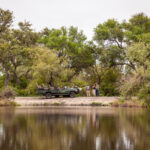Wildlife to see on Night Drives
As the light fades to dusk and the heat of the African day dissipates and the sun sinks below the horizon, a host of unusual creatures appear from the shadows to delight our guests on game drive. Take a look at some of the fantastical nocturnal creatures to add to your bucket list on safari at Kings Camp!
Aardvark
A peculiar animal to encounter on safari – the aardvark is the only surviving member of the Tubulindentata species and quite literally is the only one of its kind on earth, genetically and physically speaking. The aardvark’s name comes from the Afrikaans meaning ‘earth pig’ – a nod to its unique appearance combining the ears of a donkey, the snout of a pig, the tail of a kangaroo and a long pink tongue and big, sharp claws.
Aardvarks occur across sub-Saharan Africa, yet asking to see one on safari might be met with a look of consternation from your guide. They are notoriously elusive thanks to their low density across landscapes and nocturnal habits. Even seasoned safari guides can probably count on one hand the amount of times they’ve seen one – which is why spotting an aardvark has become a bucket-list experience.
Honey Badger
A notorious creature that many guests have never even heard of, the honey badger is a fearsome animal found across Africa and into the Middle East & India. Kings Camp is situated in the perfect habitat for honey badgers to thrive in and luckily for our guests, they are sometimes relaxed enough to spot in broad daylight.
Honey badgers owe much of their success to their toughness and unfussy diet – they will eat almost anything small enough that they can get their claws on. Their preferred foods include scorpions, snakes, insect larvae, small rodents and, as the name suggests, honey! They use their excellent sense of smell to sniff out food and then their long powerful claws to dig it out. Infamous for their toughness, honey badgers will tuck into a piece of honeycomb without flinching at the swarm of angry bees circling overhead or come out of an interaction with lions or leopards alive and having scared off their attackers!
Bat-eared Fox
Recognisable by their huge bat wing-like ears, bat-eared foxes are found across Eastern and Southern Africa and are a delightful sighting on game drives in the Timbavati. Being largely nocturnal, bat-eared foxes are often spotted on night drives, however in South Africa, they are nocturnal only in the summer and diurnal during the winter.
Like other canids, bat-eared foxes are mostly monogamous and den with their litters for safety. They use their enormous ears to pick up the sounds of insects in the dark – but also as thermoregulation in the often hot, dry habitats they can be found in.
Aardwolf
Despite being prevalent across Southern Africa, the aardwolf is one of Africa’s most elusive animals topping many seasoned safari-goers’ bucket lists. Aardwolves are not actually wolves at all, their name derives from the Afrikaans for ‘earth wolves’ and they are in fact part of the hyena family.
Equipped with a characteristic mane, fawn colouring and dark stripes they are often mistaken for brown or striped hyenas. But unlike their brown and striped cousins, the aardwolf prefers to forage for insect larvae – predominantly termites and can consume up to 200,000 at a time – almost 1kg.
Aardwolf pairs mate for life and modern dads assist with raising the cubs. Aardwolf babies spend the first month of their lives inside their den with fathers standing guard outside. They begin to join in nightly foraging sessions at around 4 months old and will set off on their own independent lives after about a year.
Pangolin
Pangolins are shy, nocturnal animals that have become known worldwide as the most trafficked mammal in the world. Despite scales giving them an almost reptilian appearance, pangolins are in fact one of the most ancient mammalian species – Pholidota, going back nearly 64 million years in the fossil record.
Eight species of pangolin live across Asia and Africa and four are found in southern and east Africa. They prefer scrubby, savannah woodland and dig burrows with spherical chambers which can sometimes be large enough for a person to stand up in! Pangolins often ‘adopt’ the abandoned burrows or warthogs and aardvarks and make them their own.
It’s difficult to know how many pangolins are left in the wild, as there have been no successful population studies completed. What we do know is that their populations can’t possibly sustain the decimation caused by the illegal wildlife trade – ripping approximately 200,000 pangolins from the wild every year.
Porcupine
The porcupines found in the Greater Kruger area are the largest on earth. They are a species of rodent covered in fearsome black and white quills, up to 50cm long, used for protection against predators. Porcupines aren’t fussy when it comes to choosing their habitat and can adapt well to different climates. They typically find refuge in unused aardvark burrows, modifying them for their own use of digging their own.
Porcupines are herbivores, meaning they eat most vegetarian, but will chew on bones for important minerals and eat insects and lizards. Females give birth to one to three babies at a time – called porcupettes! At birth, they have soft quills which harden as they get older.
Stay With Us
Book your Timbavati safari and come and see how many of the nocturnal creatures on our list you can tick off on safari. Enquire via email at book@kingscamp.com or fill in our online booking form here.
We look forward to welcoming you to Kings Camp!





